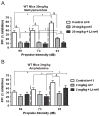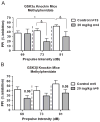Examination of methylphenidate-mediated behavior regulation by glycogen synthase kinase-3 in mice
- PMID: 23099259
- PMCID: PMC3610174
- DOI: 10.1016/j.ejphar.2012.10.018
Examination of methylphenidate-mediated behavior regulation by glycogen synthase kinase-3 in mice
Abstract
Abnormalities in dopaminergic activity have been implicated in psychiatric diseases, such as attention deficit hyperactivity disorder (ADHD), and are treated with therapeutic stimulants, commonly methylphenidate or amphetamine. Amphetamine administration increases glycogen synthase kinase-3 (GSK3) activation, which is necessary for certain acute behavioral responses to amphetamine, including increased locomotor activity and impaired sensorimotor gating. Here, we tested if modulating GSK3 by administration of the GSK3 inhibitor lithium or expression of constitutively active GSK3 altered behavioral responses to methylphenidate administered to mice acutely or daily for 8 days. Methylphenidate or amphetamine was administered to mice intraperitoneally for 1 or 8 days. Open-field activity and pre-pulse inhibition (PPI) were measured. In contrast to lithium's blockade of acute amphetamine-induced locomotor hyperactivity, lithium treatment did not significantly reduce methylphenidate-induced locomotor hyperactivity in wild-type mice after acute or 8 days of repeated methylphenidate administration. Lithium treatment significantly increased the impairment in PPI caused by methylphenidate, but significantly reduced the amphetamine-induced PPI deficit. In GSK3 knockin mice, expression of constitutively active GSK3β, but not GSK3α, significantly increased locomotor hyperactivity after acute methylphenidate treatment, and significantly impaired PPI, preventing further methylphenidate-induced impairment of PPI that was evident in wild-type mice and GSK3α knockin mice. Lithium does not counteract locomotor activity and PPI responses to methylphenidate as it does these responses to amphetamine, indicating that different mechanisms mediate these behavioral responses to methylphenidate and amphetamine. Only active GSK3β, not GSK3α, modulates behavioral responses to MPH, indicating selectivity in the actions of GSK3 isoforms.
Copyright © 2012 Elsevier B.V. All rights reserved.
Figures





Similar articles
-
Brain region differences in regulation of Akt and GSK3 by chronic stimulant administration in mice.Cell Signal. 2012 Jul;24(7):1398-405. doi: 10.1016/j.cellsig.2012.03.001. Epub 2012 Mar 10. Cell Signal. 2012. PMID: 22434044 Free PMC article.
-
Inhibition of GSK3 attenuates amphetamine-induced hyperactivity and sensitization in the mouse.Behav Brain Res. 2012 May 16;231(1):217-25. doi: 10.1016/j.bbr.2012.03.027. Behav Brain Res. 2012. PMID: 22649795 Free PMC article.
-
GSK3β isoform-selective regulation of depression, memory and hippocampal cell proliferation.Genes Brain Behav. 2016 Mar;15(3):348-55. doi: 10.1111/gbb.12283. Epub 2016 Feb 12. Genes Brain Behav. 2016. PMID: 26749572 Free PMC article.
-
The pharmacology of amphetamine and methylphenidate: Relevance to the neurobiology of attention-deficit/hyperactivity disorder and other psychiatric comorbidities.Neurosci Biobehav Rev. 2018 Apr;87:255-270. doi: 10.1016/j.neubiorev.2018.02.001. Epub 2018 Feb 8. Neurosci Biobehav Rev. 2018. PMID: 29428394 Free PMC article. Review.
-
Methylphenidate (Ritalin): behavioral studies in the rat.Int J Neurosci. 2007 Jun;117(6):757-94. doi: 10.1080/00207450600910176. Int J Neurosci. 2007. PMID: 17454243 Review.
Cited by
-
Methylphenidate administration promotes sociability and reduces aggression in a mouse model of callousness.Psychopharmacology (Berl). 2019 Sep;236(9):2593-2611. doi: 10.1007/s00213-019-05229-9. Epub 2019 Apr 6. Psychopharmacology (Berl). 2019. PMID: 30955107
-
Wnt signaling networks in autism spectrum disorder and intellectual disability.J Neurodev Disord. 2016 Dec 5;8:45. doi: 10.1186/s11689-016-9176-3. eCollection 2016. J Neurodev Disord. 2016. PMID: 27980692 Free PMC article. Review.
-
Multiple Drug Treatments That Increase cAMP Signaling Restore Long-Term Memory and Aberrant Signaling in Fragile X Syndrome Models.Front Behav Neurosci. 2016 Jun 30;10:136. doi: 10.3389/fnbeh.2016.00136. eCollection 2016. Front Behav Neurosci. 2016. PMID: 27445731 Free PMC article.
-
Behavioral, Neurochemical and Developmental Effects of Chronic Oral Methylphenidate: A Review.J Pers Med. 2023 Mar 23;13(4):574. doi: 10.3390/jpm13040574. J Pers Med. 2023. PMID: 37108960 Free PMC article. Review.
-
From attention-deficit hyperactivity disorder to sporadic Alzheimer's disease-Wnt/mTOR pathways hypothesis.Front Neurosci. 2023 Feb 16;17:1104985. doi: 10.3389/fnins.2023.1104985. eCollection 2023. Front Neurosci. 2023. PMID: 36875654 Free PMC article.
References
-
- Ago Y, Tanaka T, Kita Y, Tokumoto H, Takuma K, Matsuda T. Lithium attenuates methamphetamine-induced hyperlocomotion and behavioral sensitization via modulation of prefrontal monoamine release. Neuropharmacol. 2012;62:1634–1639. - PubMed
-
- Beaulieu JM, Sotnikova TD, Gainetdinov RR, Caron MG. Paradoxical striatal cellular signaling responses to psychostimulants in hyperactive mice. J Biol Chem. 2006;281:32072–32080. - PubMed
-
- Cantwell DP. Attention deficit disorder: a review of the past 10 years. J Am Acad Child Adolesc Psychiatry. 1996;35:978–987. - PubMed
Publication types
MeSH terms
Substances
Grants and funding
LinkOut - more resources
Full Text Sources
Other Literature Sources

